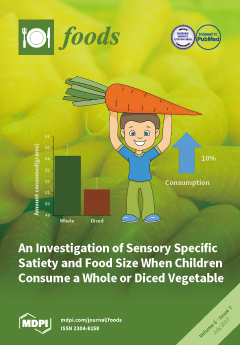Dark green leafy vegetables (DGLVs) are considered as important sources of iron and vitamin A. However, iron concentration may not indicate bioaccessibility. The objectives of this study were to compare the nutrient content and iron bioaccessibility of five sweet potato cultivars, including three
[...] Read more.
Dark green leafy vegetables (DGLVs) are considered as important sources of iron and vitamin A. However, iron concentration may not indicate bioaccessibility. The objectives of this study were to compare the nutrient content and iron bioaccessibility of five sweet potato cultivars, including three orange-fleshed types, with other commonly consumed DGLVs in Ghana: cocoyam, corchorus, baobab, kenaf and moringa, using the in vitro digestion/Caco-2 cell model. Moringa had the highest numbers of iron absorption enhancers on an “as-would-be-eaten” basis, β-carotene (14169 μg/100 g;
p < 0.05) and ascorbic acid (46.30 mg/100 g;
p < 0.001), and the best iron bioaccessibility (10.28 ng ferritin/mg protein). Baobab and an orange-fleshed sweet potato with purplish young leaves had a lower iron bioaccessibility (6.51 and 6.76 ng ferritin/mg protein, respectively) compared with that of moringa, although these three greens contained similar (
p > 0.05) iron (averaging 4.18 mg/100 g) and β-carotene levels. The ascorbic acid concentration of 25.50 mg/100 g in the cooked baobab did not enhance the iron bioaccessibility. Baobab and the orange-fleshed sweet potato with purplish young leaves contained the highest levels of total polyphenols (1646.75 and 506.95 mg Gallic Acid Equivalents/100 g, respectively;
p < 0.001). This suggests that iron bioaccessibility in greens cannot be inferred based on the mineral concentration. Based on the similarity of the iron bioaccessibility of the sweet potato leaves and cocoyam leaf (a widely-promoted “nutritious” DGLV in Ghana), the former greens have an added advantage of increasing the dietary intake of provitamin A.
Full article






